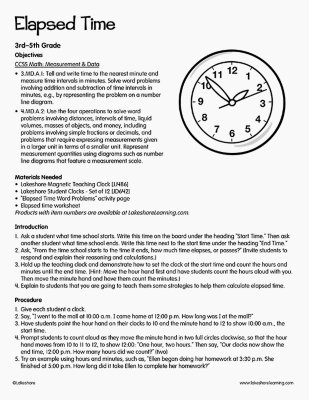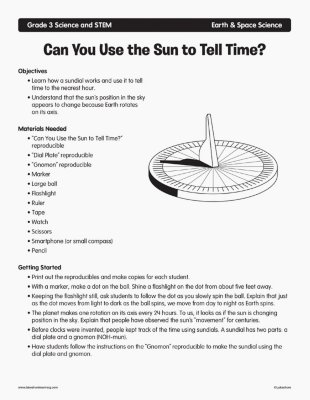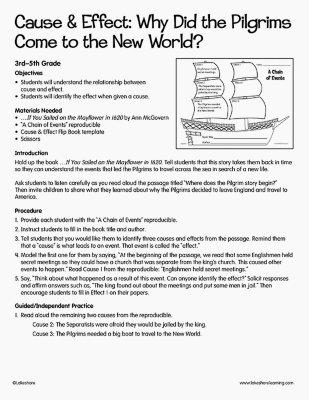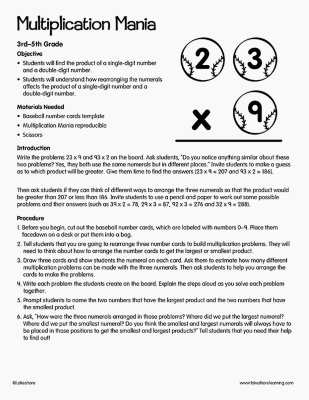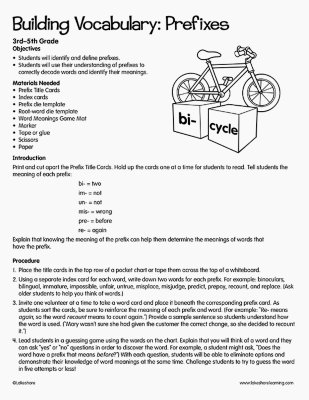Narrow by Grade
- Infant (0)
- Toddler (0)
- Preschool (0)
- Pre-K (0)
- Kindergarten (0)
- 1st (0)
- 2nd (0)
- 3rd (7)
- 4th (4)
- 5th (0)
- 6th & Up (0)
Grade
Narrow by Age
- 0-18m (1)
- 18-36m (1)
- 3 yrs. (0)
- 4 yrs. (3)
- 5 yrs. (7)
- 6 yrs. (3)
- 7 yrs. (2)
- 8 yrs. (7)
- 9 yrs. (4)
- 10 yrs. (2)
- 11 yrs. & Up (0)
Age 8 yrs.
0 results for "time timer" , here are results for "time times"
Filters
Clear All
Elapsed Time
3rd Grade - 4th Grade
Objectives CCSS Math: Measurement & Data 3.MD.A.1: Tell and write time to the nearest minute and measure time intervals in minutes. Solve word problems involving addition and subtraction of time intervals in minutes, e.g., by representing the problem on a number line diagram. 4.MD.A.2: Use the four operations to solve word problems involving distances, intervals of time, liquid volumes, masses of objects, and money, including problems involving simple fractions or decimals, and problems that require expressing measurements given in a larger unit in terms of a smaller unit. Represent measurement quantities using diagrams such as number line diagrams that feature a measurement scale. Materials Needed Lakeshore Magnetic Teaching Clock Lakeshore Student Clocks - Set of 12 “Elapsed Time Word Problems” activity page Elapsed time worksheet Introduction Ask a student what time school starts. Write this time on the board under the heading “Start Time.” Then ask another student what time school ends. Write this time next to the start time under the heading “End Time.” Ask, “From the time school starts to the time it ends, how much time elapses, or passes?” (Invite students to respond and explain their reasoning and calculations.) Hold up the teaching clock and demonstrate how to set the clock at the start time and count the hours and minutes until the end time. (Hint: Move the hour hand first and have students count the hours aloud with you. Then move the minute hand and have them count the minutes.) Explain to students that you are going to teach them some strategies to help them calculate elapsed time.
View Lesson PlanCan You Use the Sun to Tell Time?
3rd Grade
Objectives
- Learn how a sundial works and use it to tell time to the nearest hour.
- Understand that the sun’s position in the sky appears to change because Earth rotates on its axis.
Cause & Effect: Why Did the Pilgrims Come to the New World?
3rd Grade
Objectives Students will understand the relationship between cause and effect. Students will identify the effect when given a cause. Materials Needed …If You Sailed on the Mayflower in 1620 by Ann McGovern “A Chain of Events” reproducible Cause & Effect Flip Book template Scissors Introduction Hold up the book …If You Sailed on the Mayflower in 1620. Tell students that this story takes them back in time so they can understand the events that led the Pilgrims to travel across the sea in search of a new life. Ask students to listen carefully as you read aloud the passage titled “Where does the Pilgrim story begin?” Then invite children to share what they learned about why the Pilgrims decided to leave England and travel to America.
View Lesson PlanClose Reading and Text Features
3rd Grade - 4th Grade
Objectives CCSS Reading: Informational Text RI.3.7: Use information gained from illustrations (e.g., maps, photographs) and the words in a text to demonstrate understanding of the text (e.g., where, when, why, and how key events occur). RI.4.7: Interpret information presented visually, orally, or quantitatively (e.g., in charts, graphs, diagrams, time lines, animations, or interactive elements on Web pages) and explain how the information contributes to an understanding of the text in which it appears. Materials Needed “Three Cheers for Engineers!” reading passage Paper and pencils Introduction Provide students with a copy of the “Three Cheers for Engineers!” reading passage. Tell students, “Today we are going to read a passage titled, “Three Cheers for Engineers!” One practice of good readers is that they pay close attention to the text. As we read, I want you to think about the meaning of the text, the words that are used and other features on the page that are used to help interpret the text.”
View Lesson PlanCause and Effect
3rd Grade - 4th Grade
Objective CCSS Reading: Informational Text RI.3.3: Describe the relationship between a series of historical events, scientific ideas or concepts, or steps in technical procedures in a text, using language that pertains to time, sequence, and cause/effect. Materials Needed “The Earthquake that Changed Earth” nonfiction reading selection “The Earthquake that Changed Earth” graphic organizer and sample graphic organizer Cause & Effect Flip Book template Scissors Pencils or markers A copy of any other nonfiction text
View Lesson PlanMultiplication Mania
3rd Grade
Objectives Students will find the product of a single-digit number and a double-digit number. Students will understand how rearranging the numerals affects the product of a single-digit number and a double-digit number. Materials Needed Baseball number cards template Multiplication Mania reproducible Scissors Introduction Write the problems 23 x 9 and 93 x 2 on the board. Ask students, “Do you notice anything similar about these two problems? Yes, they both use the same numerals but in different places.” Invite students to make a guess as to which product will be greater. Give them time to find the answers (23 x 9 = 207 and 93 x 2 = 186). Then ask students if they can think of different ways to arrange the three numerals so that the product would be greater than 207 or less than 186. Invite students to use a pencil and paper to work out some possible problems and their answers (such as 39 x 2 = 78, 29 x 3 = 87, 92 x 3 = 276 and 32 x 9 = 288).
View Lesson PlanBuilding Vocabulary: Prefixes
3rd Grade - 4th Grade
Objectives Identifying and knowing the meaning of the most common prefixes and derivational suffixes Determining the meaning of the new word formed when a known affix is added to a known word Using common, grade-appropriate Greek and Latin affixes and roots as clues to the meaning of a word Materials Needed Prefix title cards Index cards Prefix die template Root-word die template Word meanings game mat Marker Tape or glue Scissors Paper Pocket chart or whiteboard Introduction Print and cut apart the prefix title cards. Hold up the cards one at a time for students to read. Tell students the meaning of each prefix: bi- = two im- = not un- = not mis- = wrong pre- = before re- = again Explain that knowing the meaning of the prefix can help them determine the meanings of words that have the prefix.
View Lesson Plan